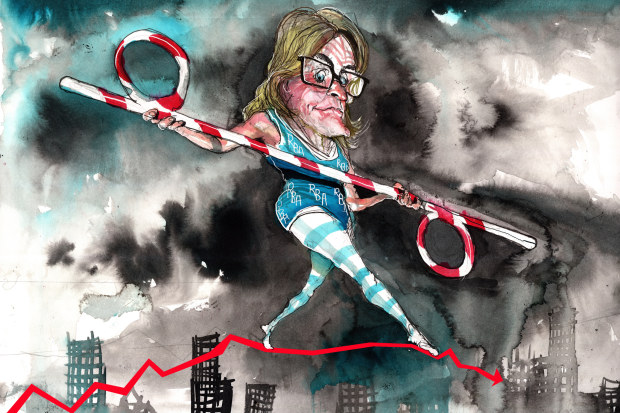Chanticleer

War, house prices and Aussies with two jobs: big forces are colliding
Rising oil prices, higher bond yields and persistently high house prices are colliding with signs of economic pressure.
One way to read the sharp 1.5 per cent drop on the ASX 200 on Thursday is as a sign of investor confusion at the multiple forces buffeting the Australian economy.
Market are clearly worried that inflationary pressures are cementing a higher-for-longer narrative in the US and Australia.

RBA governor Michele Bullock faces a tough decision next month. David Rowe
Yet another surge in bond yields on Wall Street on Wednesday night was followed by a similar rise Down Under, with Australia’s 10-year bond yield hitting 4.75 per cent, the highest since 2011. The US 10-year yield jumped to a new cycle high of 4.94 per cent, a level last seen in 2007.
But sentiment on both bond and equity markets isn’t being helped by what JP Morgan chief executive Jamie Dimon last week described as “the most dangerous time the world has seen in decades” following the outbreak of conflict between Israel and Hamas.
The threat of the conflict spreading in the region pushed oil prices higher on Wednesday night. It is no coincidence that RBA governor Michele Bullock and Treasurer Jim Chalmers have both pointed to petrol prices as a threat to the RBA’s inflation fight in the past two days.
“We’ve just got shock, after shock, after shock,” Bullock said on Wednesday.
The governor also used that appearance to express her surprise at the resilience in house prices, adding to concerns expressed in the minutes of the RBA’s October meeting about potential inflationary pressures from rising house prices and rents.
CoreLogic’s daily house price indices suggest this worry is unlikely to recede quickly either. The aggregate of prices across Australia’s five big capital cities has risen about 0.5 per cent this month, with the 12-month gain running at 6.6 per cent. In Sydney, prices are 8.4 per cent higher than a year ago.
Pressure for rate rise
At first glance, Thursday’s employment data added further pressure on the RBA to deliver another rate rise at its next meeting on Melbourne Cup day. In a surprise to most economists, the unemployment rate fell from 3.7 per cent to 3.6 per cent.
But on closer inspection, the employment data revealed more signs of softness in a historically tight labour market.
The economy generated just 6700 jobs in September, and actually shed almost 40,000 full-time jobs. Commonwealth Bank economist Gareth Aird also notes that when we step back from the noise of monthly data, we see that trend employment growth has slowed over the past five months, from 37,000 jobs in April to 23,000 in September.
Westpac’s Ryan Wells notes there is an emerging softness in hours worked, which fell 0.4 per cent in September after falling 0.5 per cent in August.
“In essence, employers are less willing to provide hours but are not yet materially reducing their workforce,” Wells says. “This provides another signal that the Australian labour market is at a turning point – no longer tightening, but it is yet to slacken by a significant degree.”
Another striking data point highlighted from Aird (albeit from the latest quarterly employment data) shows that the share of workers doing more than one job is sitting at a record high of about 6.7 per cent. That equates to 1.1 million workers holding down two or more jobs, which Aird says suggests the growing pain of cost-of-living pressures, particularly for those who rent or have a mortgage.
The overall picture is one of big forces colliding to make life difficult for investors and the central bankers alike.
On the one hand, the threat of another burst of inflation from higher oil prices and resurging housing markets are feeding the higher-for-longer narrative that is pushing bond yields high. On the other hand, signs of economic weakness are emerging, whether it’s the number of Australians working two or more jobs, the fact that 13 per cent of households have income below their expenses, as reported in the RBA’s latest financial stability review, or weakness in discretionary consumer spending.
Lifting rates in the face of a slowing economy has not typically been a recipe for economic strength or investor returns. Next week’s inflation data for the September quarter will tell us if the RBA has to do just that.
Introducing your Newsfeed
Follow the topics, people and companies that matter to you.
Find out moreRead More
Latest In Economy
Fetching latest articles